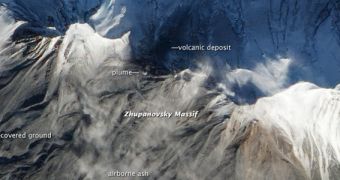One of the latest images produced by the NASA Earth-Observing 1 (EO-1) satellite highlights telltale signs that the Zhupanovsky Volcano, in the Kamchatka Peninsula, Russia, is getting ready to erupt again. The spacecraft's keen sensors were able to observe minute signs of the impending eruption during an overflight that took place on Tuesday, November 5.
Scientists with the Global Volcanism Program say that Zhupanovsky produces so-called phreatic, or ultravulcanian, eruptions. These are caused by hot magma under the surface heating ground or surface water above. The magma has a temperature of 500 to 1,170°C (932 to 2,138 °F).
When magma nears the surface, it causes the near-instantaneous vaporization of water, which in turn results in a vast explosion of water, ash, volcanic bombs and heated rocks. Recent data from the NASA Terra satellite indicate infrared anomalies (excess heat) under the volcano and Steam emissions.
The EO-1 image above was collected in visible wavelengths, and shows bare rock in tan, the northern slopes of the volcano in blue, ash in light gray and the mountain's ridges in white. There is currently no way of telling if and when a large eruption will occur here.

 14 DAY TRIAL //
14 DAY TRIAL //